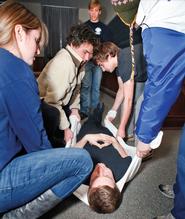
Whenever there is a medical emergency on the Hamilton College campus, student EMTs are always the first-responders. The Hamilton College Emergency Medical Services (HCEMS) team consists of 25 students from varied backgrounds and interests. This week marks the National Collegiate Emergency Services Foundation’s National Collegiate EMS week, during which Hamilton recognizes the efforts of its student EMTs.
The current members of HCEMS include seniors Philip Conkling, Jenna Durkee, Liza Gergenti, Tara Hansen, Robert Hayden, Jacquelyn Jasuta, Spencer Olsson and James Stanell. The members from the junior class are Amal Asghar, Katherine Callahan, Ian Carradine, Laura McCormick, Lillian McCullough, Kathleen Moran, Marie Murray and Amy Wright. Sophomores on the squad are Hannah Ferris, Emily Foley, Blaire Frett, Kate Getman, Brian Jung, Sara Lewis, Keara Lynn, Louise Owens and Luis Serota.
Typically, most students become EMTs primarily out of a desire to help others out of emergency situations and set them on the road to recovery. But the position is not all work. The HCEMS team forms its own peer group—students train together for the spring semester before subsequently working together throughout the year. The close personal ties add to the cohesion of the group and thus the effectiveness of the emergency medical service.
Each EMT works approximately two shifts per week for about 10 to 12 hours at a time; a pair of EMTs is on call 24 hours per day, seven days a week. In addition to responding to every medical emergency, the students are required to keep track of their medical equipment. These many responsibilities make being an EMT an understandably stressful position. Newly-certified “rookie” EMTs are paired with veterans until they become comfortable and proficient at working in emergency situations.
Selecting the right team of EMTs is integral to the effectiveness of the group. Director of Emergency Medical Services Diann Lynch helps select the new recruits for the program. She looks for students who are team players, manage stress well and stay calm in emergencies. Furthermore, members of HCEMS must be willing to work in a group. Rookie EMTS often learn proficiency in emergency medicine from their more experienced peers.
The student EMTs are certified during the spring semester. students attend three hours of class per week and take part in a lab over weekends. The instruction is free; students need only pay for their books and supplies. After the spring training, the students are prepared to work as part of the HCEMS team.
The campus community depends on the presence of the EMTs to form a safety net against medical emergencies. They ensure that each ill or injured student is cared for and seen through to the recovery process. Their service is appreciated year round, but this week in particular we recognize their dedication and benefit to the campus community.
